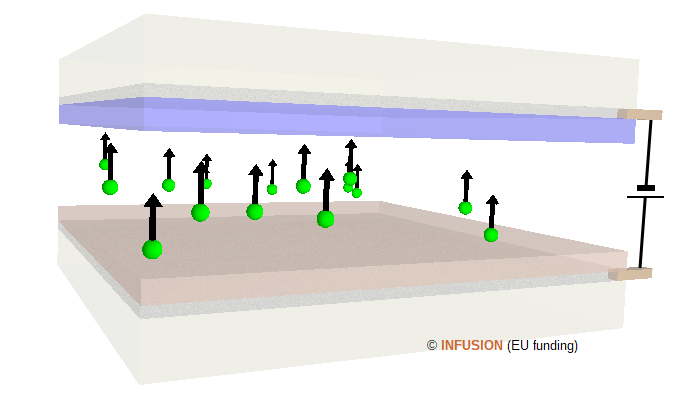Windows
Electrochromes are used at the industrial level for the realization of smart windows. In this application, the device works in transmittance, the electrochromic layers playing the role of a dimmable light shutter whose transparency is controlled by an external power. The transmittance of the window is adjusted automatically or manually according to the intensity of the sun light and heat getting in. The color of the electrochrome is less important than its opacity, except in the bleached stage where the color should be as neutral as possible. The overall transmittance of the window in the bleached stage must exceed 80%.
|
The device schematized in the opposite image contains two complementary electrochromes, an anodic one (light brown layer in the bottom part) and a cathodic one (blue layer in the top part). Upon application of an electric potential difference between the two transparent electrodes (thin layers in contact with glass substrates), ions move from one electrochrome layer to the other across an ionic conducting buffer. The de-insertion and insertion of the ions in the electrochromes switch them to their colored stage. By suppressing the bias, the ions move back and the device returns to its bleached stage. A possible pair of complementary electrochromes is Li-doped NiO (anodic) and WO3 (cathodic), both used as thin films. The ions are Li+ and the ionic conductor is a Li compound [1]. Another interesting pair is a PEDOT derivative (cathodic) combined with Prussian blue (anodic) [2]. |
 |
Electrochromic smart windows are becoming important for the realization of energy-efficient buildings. Their use, however, is not limited to buildings. The cabin windows of the long-haul B787 aircraft incorporate an electrochromic dimming curtain. The passenger sitting next to a window can customize how much light goes through it simply by turning a knob. The cabin crew have a master control on the darkness of the windows, which they may use to create an artificial night during the flight. In the picture below, four windows are represented. The one on the left has 90% neutral transparency (bleached stage), the three others are in the colored stage with 75%, 50% and 25% transparency.

- "An all-solid-state electrochromic device based on NiO/WO3 complementary structure and solid hybrid polyelectrolyte" J.ZhangaJ.P.TuaX.H.XiaaY.QiaobY.Lu, Solar Ener. Mater. Solar Cells 93 (2009) 1840-5 [DOI: 10.1016/j.solmat.2009.06.025].
- "Large-area electrochromic devices on flexible polymer substrates with high optical contrast and enhanced cycling stability", S. Macher, M. Schott, M. Dontigny, A. Guerfi, K. Zaghib, U. Posset, and P. Löbmann, Adv. Mater. Technol. 6 (2021) 2000836 [DOI: 10.1002/admt.202000836].